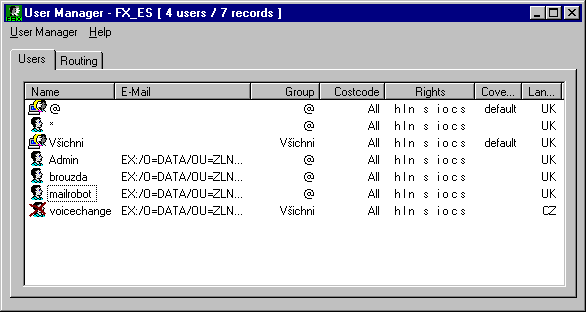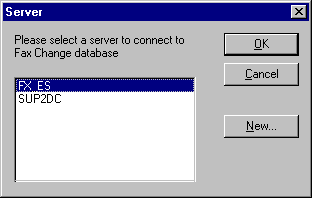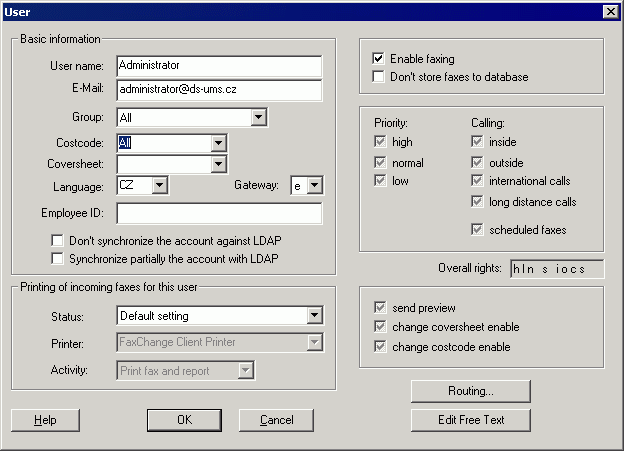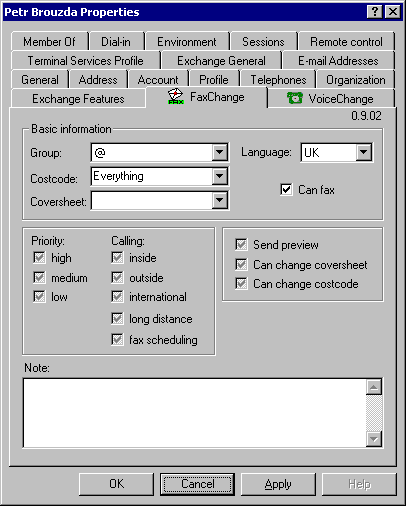The fxUserM program is used for administration of the user database - it allows to change any user setting.
You may want to use read-only mode in some situation, i.e. you can only view settings, but not to change it
(for example when user settings are synchronized with LDAP server, which is authoritative settings source).
Read-only mode is activated by creating string value "HKLM\SOFTWARE\Datasys\FaxChange\utils\FXUserM\ReadOnly=1" in registry
on the FaxChange server. Full edit mode is turned on by setting 0 here.
If you are not sure, what is "user group", "fax routing" etc., read Introduction into Faxchange administration.


Connection to the server
After starting User Manager you must select a server where user database is located.
You can select one of the currently available servers from the list.
Press the "New" button to add a new server into the list.
Main Menu - User Manager
Program functions:
Edit Users
The "Users" tab displays a list of users, groups and distribution lists.
Record type is marked with an icon. You can start user editing when you click with
the right mouse button on the user icon and select Edit command.
Displayed columns
The list contains the following columns: Name (name of the user or group), E-mail (address in form depenedent on gateway), Group, Costcode,
Rights, Coversheet, Language. Items in the Rights column are displayed in abbreviated form using the following letters:
h ... high priority
l ... low priority
n ... normal priority
s ... scheduled faxes
i ... calls within the exchange enabled
o ... calls outside the exchange enabled
c ... long distance calls
s ... international calls
If the user or the group has a particular right assigned, a letter will be displayed, otherwise dash will be displayed.
Rights are displayed in their effective value, i.e. if a record is set to "default", setting from group or from default group
will be displayed.
Sorting
Records can be sorted according to each column by clicking the mouse on the column header. Press the [F5] key to recall
the last set sorting.
Context Menu
A user can be edited by clicking the right mouse button on the user name; a context menu will be displayed with options:
Edit
The Edit option becomes available when you choose one record or more records of the
same type. In both cases, a dialog box will appear containing some or all of the following options (depending on the record type).
Record Edit dialog box:

[Block of basic information]
User Name - name of the user, group or distribution list based on the record type. The value can be changed.
E-mail - e-mail address of the user or group. Value can be changed.
Group - name of the group to which the user
belongs. You can select one of the existing groups from the list.
Costcode - preset accounting group for a specific user. You can select it from the list or enter a new value.
Coversheet - preset coversheet (fax cover page) for a specific user (filename). You can select a value from the list
of the existing coversheets or enter a new value. Coversheets are stored in the subfolders under /faxchange/data/cover.
Language - select which language Faxchange uses for comunication with this user.
Gateway - select gatewaye, which will be used for mail delivering to the user (e = Exchange, s = SMTP, l = Lotus Notes, x = application
gateway).
Employee ID - for internal use of your company, Faxchange doesn't use this item.
Don't synchronize account against LDAP - record will not be synchronized using fxLdapsync.
Synchronize partially with LDAP - fxLdapsync synchronizes only Employee ID and costcode.
More about synchronization with LDAP is described here.
Enable faxing - specifies whether user (group) can send faxes. If checked, you can set appropriate rights.
Don't store faxes to database - faxes of this user will not be archived. Using this option you can archives only faxes
from important users, not all fax traffic. It saves space in the database.
[Block of rights] - this specifies what fax types is user authorised to send.
Priority: high, normal, low.
Calling: inside - within the exchange, outside - outside the exchange, long distance - long distance faxes, international -
international faxes.
Scheduled faxes: delayed sending for a later time.
Each option can also have a medium value (grey check box) apart of enabled/disabled value, which means that value will be taken
from the group to which the user belongs in case of users, or default value will be taken in the case of groups.
Overall rights: shows an effective setting of rights,
i.e. it fills the items that are set to default with values from the group or the default group.
Send preview: you can select whether particular user should receive previews before fax is sent or not. Before user
sends a fax he can set whether he wants to receive preview or not regardless of the setting in fxUserM program.
Change coversheet enable: if a user has this right he can select coversheet other than one preset by administrator before
he sends a fax.
Change costcode enable: user with this right is allowed to change costcode for fax being sent.
The Routing... button opens a list of the routing
rules valid for the current user. See Edit routing.
The Edit Free Text button: reserved for future use, here will be possible to configure new functions.
Some user settings are stored here.
[Block of incoming faxes printing setting for this user] - FaxChange gives a possibility of printing received faxes and reports.
This feature can be customized for each recipient.
In Status field select in which manner printing will be done, options:
- Default setting - settings from fxCfg are valid (so if printing is off there, nothing will be printed)
- Only on the selected printer - printing occurs on the selected printer only, see next
- Default setting and on the next printer - printing according to the fxCfg settings and on the another selected printer also
In Printer field select user printer, where print jobs will be directed to.
Activity field sets what data will be printed - faxes, reports, both or nothing.
Copy
Shows dialog for creating a new record of the same type as record on which this function was selected. New record settings will be
copied from record, on which this function was selected.
Faxing disable/enable
Disables/enables user to send faxes. It will be indicated by crossed user icon in User manager window. If user tries to send a fax, he will
receive mail message with warning that he has no permission to send faxes. This can also be called up by pressing [DEL] key on specific user.
Add Group
Shows dialog for creating a new group - enter its name and set parameters according your needs.
Add User
Shows dialog for creating a new user (without need of database synchronization) - enter its name and set parameters according your needs.
This function doesn't work, if users are stored in Active Directory.
Add distribution list
Shows dialog for creating a new distribution list (without need of database synchronization) - enter its name and set parameters according
your needs. This function doesn't work, if users are stored in Active Directory.
Delete / Delete group
Highlighted records will be deleted after confirmation. If you delete group, users belonging to to this deleted groups will be moved
to @ default group. This can be called up also by pressing the [DEL] key on the group.
[back to main menu]
back to top of page
Edit routing
This tab shows all routing rules (rules for routing of delivered faxes) of all types. Rule type is marked by an icon.
What ss routing for?
Incoming faxes must be distributed to individual users - preferably to those to whom they
belong. Proper routing can be set on the "Routing" tab in User manager.
Faxes in FaxChange can be divided according to three criteria:
- PABX. If your exchange supports dialling prefix and
"virtual fax numbers" it will pass the telephone number that is currently
being called to the fax server. For example, one user can have telephone number 4444100,
another one 4444101, the third one 4444102; however, calling to any of these numbers will
ring on one physical line connected to fax card and exchange will pass last three digits
of the telephone number to the fax card. In User manager, set PABX routing for each virtual line to its owner.
- CSID. CSID is identification number of incoming fax. If
you want all faxes from +420 2 421442 CSID to be automatically sent to XY user, set CSID routing at this point.
You can specify to which sender this CSID belongs in "description" item (user name will be added to From: box of the
received message)
- Line. Also called Service routing. If no PABX or CSID are available for delivered fax, it is distributed according
to physical fax line number through which it arrived. Service routing is usually directed to the secretary who
redistributes received faxes.
The faxserver first tries to route fax according to CSID, then PABX and lastly according to line. If it cannot find
corresponding record (if there is no routing set), then fax will be sent to fax administrator.
Priority of routing can be changed, for more information see KBFX19990421-122653BRO.
Displayed columns
Rule list contains following columns: number (rule type icon and number are here), description, owner (to whom fax will be delivered
according to this rule) and phone number (for CSID only).
Sorting
Click by left mouse button on column header to sort list according to this column. Use the [F5] key to regenerate previous sorting.
Context Menu
Press right mouse button to view context menu with currently available actions.

Edit
If one record is selected a dialog box for setting the CSID/PABX/Line value will appear.
In case of the CSID you can enter description and telephone number.
Add route
Creates a new rule of chosen type. You must select owner for new rule from list of users and distribution lists.
Then you can enter details of this rule.
Change user
This option allows selection of new owner of this rule from list of users and distribution lists.
Remove
All selected rules will be deleted from database when you confirm the action. Also [DEL] key can be used.
[back to main menu]
back to top of page
Find / Find Next
Searches in both user list (users, groups and distribution lists) and routing list.
Enter beginning of user name as a search string (or routing number in routing list). Match inside of the name is not tested.
If we have for example user James Brown, then searching for "jam" will be successful, but not for "bro". Searching is
case insensitive.
Find action is activated through menu or by CTRL+F shortcut key, and F3 for "Find Next".
back to top of page
Save to database
Saves your changes into database. If you quit the program without saving, you'll be asked whether you want to save changes.
back to top of page
Database synchronization
This command is located in the main menu and it allows synchronization of the FaxChange
user database with the MS Exchange user database / Active Directory. It will check the
appropriate directory and executes the following actions:
- it creates users and distribution lists in Faxchange database, which exist only in the MS Exchange database / Active
directory. Parameters of new users will be taken from "*" user.
- it discards users and distribution lists which are located only in the FaxChange database. At the same time, it discards all
routing rules of deleted users and distribution lists from the database.
When using Exchange 2000 and higher, you must enter your domain name or DNS name of your damin controller and then select
administrative group, from which users are imported.
If administrator has selected Active Directory for saving FaxChange users properties, database synchronization
is not needed. User properties can be modified in Active Directory Users and Computers.
But fxUserM tool is still necessary for setting of fax routing, fax printing and properties of default FaxChange user "*" and group "@",
because these special users (for rights inheritance when adding new user) are not added to directory.

back to top of page







